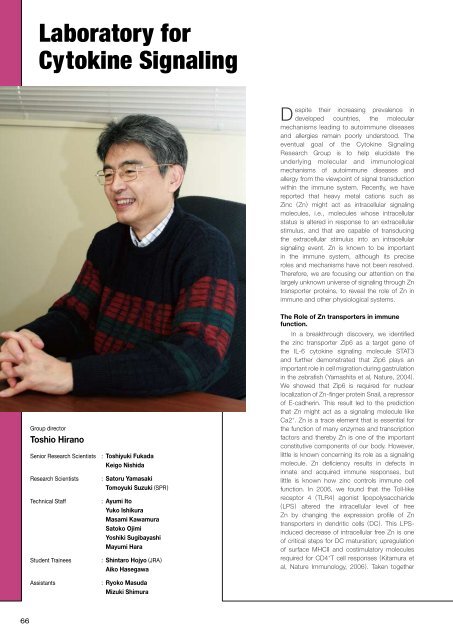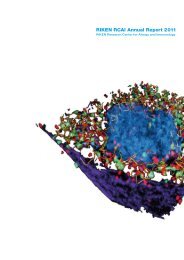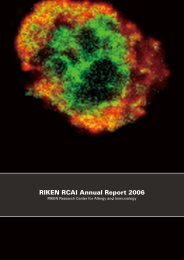in vivo
in vivo
in vivo
Create successful ePaper yourself
Turn your PDF publications into a flip-book with our unique Google optimized e-Paper software.
Laboratory for<br />
Cytok<strong>in</strong>e Signal<strong>in</strong>g<br />
Despite their <strong>in</strong>creas<strong>in</strong>g prevalence <strong>in</strong><br />
developed countries, the molecular<br />
mechanisms lead<strong>in</strong>g to autoimmune diseases<br />
and allergies rema<strong>in</strong> poorly understood. The<br />
eventual goal of the Cytok<strong>in</strong>e Signal<strong>in</strong>g<br />
Research Group is to help elucidate the<br />
underly<strong>in</strong>g molecular and immunological<br />
mechanisms of autoim mune diseases and<br />
allergy from the viewpo<strong>in</strong>t of signal transduction<br />
with<strong>in</strong> the immune system. Recently, we have<br />
reported that heavy metal cations such as<br />
Z<strong>in</strong>c (Zn) might act as <strong>in</strong>tracellular signal<strong>in</strong>g<br />
molecules, i.e., molecules whose <strong>in</strong>tracellular<br />
status is altered <strong>in</strong> response to an extracellular<br />
stimulus, and that are capable of transduc<strong>in</strong>g<br />
the extracellular stimulus <strong>in</strong>to an <strong>in</strong>tracellular<br />
signal<strong>in</strong>g event. Zn is known to be important<br />
<strong>in</strong> the immune system, although its precise<br />
roles and mechanisms have not been resolved.<br />
Therefore, we are focus<strong>in</strong>g our attention on the<br />
largely unknown universe of signal<strong>in</strong>g through Zn<br />
transporter prote<strong>in</strong>s, to reveal the role of Zn <strong>in</strong><br />
immune and other physiological systems.<br />
Group director<br />
Toshio Hirano<br />
Senior Research Scientists : Toshiyuki Fukada<br />
Keigo Nishida<br />
Research Scientists<br />
Technical Staff<br />
Student Tra<strong>in</strong>ees<br />
: Satoru Yamasaki<br />
Tomoyuki Suzuki (SPR)<br />
: Ayumi Ito<br />
Yuko Ishikura<br />
Masami Kawamura<br />
Satoko Ojimi<br />
Yoshiki Sugibayashi<br />
Mayumi Hara<br />
: Sh<strong>in</strong>taro Hojyo (JRA)<br />
Aiko Hasegawa<br />
The Role of Zn transporters <strong>in</strong> immune<br />
function.<br />
In a breakthrough discovery, we identified<br />
the z<strong>in</strong>c transporter Zip6 as a target gene of<br />
the IL-6 cytok<strong>in</strong>e signal<strong>in</strong>g molecule STAT3<br />
and further demonstrated that Zip6 plays an<br />
important role <strong>in</strong> cell migration dur<strong>in</strong>g gastrulation<br />
<strong>in</strong> the zebrafish (Yamashita et al, Nature, 2004).<br />
We showed that Zip6 is required for nuclear<br />
localization of Zn-f<strong>in</strong>ger prote<strong>in</strong> Snail, a repressor<br />
of E-cadher<strong>in</strong>. This result led to the prediction<br />
that Zn might act as a signal<strong>in</strong>g molecule like<br />
Ca2 + . Zn is a trace element that is essential for<br />
the function of many enzymes and transcription<br />
factors and thereby Zn is one of the important<br />
constitutive components of our body. However,<br />
little is known concern<strong>in</strong>g its role as a signal<strong>in</strong>g<br />
molecule. Zn deficiency results <strong>in</strong> defects <strong>in</strong><br />
<strong>in</strong>nate and acquired immune responses, but<br />
little is known how z<strong>in</strong>c controls immune cell<br />
function. In 2006, we found that the Toll-like<br />
receptor 4 (TLR4) agonist lipopolysaccharide<br />
(LPS) altered the <strong>in</strong>tracellular level of free<br />
Zn by chang<strong>in</strong>g the expression profile of Zn<br />
transporters <strong>in</strong> dendritic cells (DC). This LPS<strong>in</strong>duced<br />
decrease of <strong>in</strong>tracellular free Zn is one<br />
of critical steps for DC maturation; upregulation<br />
of surface MHCII and costimulatory molecules<br />
required for CD4 + T cell responses (Kitamura et<br />
al, Nature Immunology, 2006). Taken together<br />
Assistants<br />
: Ryoko Masuda<br />
Mizuki Shimura<br />
66





